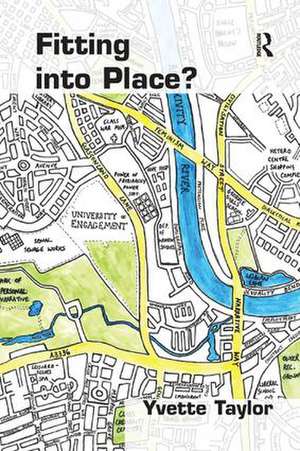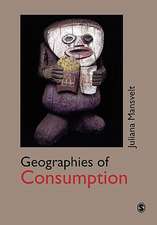Fitting into Place?: Class and Gender Geographies and Temporalities
Autor Yvette Tayloren Limba Engleză Paperback – 17 noi 2016
| Toate formatele și edițiile | Preț | Express |
|---|---|---|
| Paperback (1) | 469.34 lei 6-8 săpt. | |
| Taylor & Francis – 17 noi 2016 | 469.34 lei 6-8 săpt. | |
| Hardback (1) | 1054.71 lei 6-8 săpt. | |
| Taylor & Francis – 13 mar 2012 | 1054.71 lei 6-8 săpt. |
Preț: 469.34 lei
Nou
Puncte Express: 704
Preț estimativ în valută:
89.81€ • 93.58$ • 74.36£
89.81€ • 93.58$ • 74.36£
Carte tipărită la comandă
Livrare economică 03-17 aprilie
Preluare comenzi: 021 569.72.76
Specificații
ISBN-13: 9781138267985
ISBN-10: 1138267988
Pagini: 208
Dimensiuni: 156 x 234 x 11 mm
Greutate: 0.45 kg
Ediția:1
Editura: Taylor & Francis
Colecția Routledge
Locul publicării:Oxford, United Kingdom
ISBN-10: 1138267988
Pagini: 208
Dimensiuni: 156 x 234 x 11 mm
Greutate: 0.45 kg
Ediția:1
Editura: Taylor & Francis
Colecția Routledge
Locul publicării:Oxford, United Kingdom
Notă biografică
Yvette Taylor is a Professor and Head of the Weeks Centre for Social and Policy Research at the London South Bank University, UK and editor of Classed Intersections: Spaces, Selves, Knowledges.
Recenzii
Prize: Honoured at the Geographical Perspectives on Women Book Event at the 2012 AAG
"Fitting into Place? is a major contribution to our understanding of gender and social class inequalities in the twenty-first century. Strongly theorised, yet powerfully grounded in a range of voices across social difference, its rich tapestry of qualitative research weaves together space and place with actions, attitudes and the affective. The book is "a must-read" for anyone interested in contemporary class and gender formation."
- Diane Reay, University of Cambridge, UK
"Yvette Taylor's extraordinary book brings out into the open the structural violence of social class in Britain. It is much more than just a trenchant analysis. Through her profound attentiveness to the lives of working class women in the north east we access a deep sense of how the complexities of de-industrialisation furnish the cultural landscapes of class and gender. The result is an expansive and textured account of working class life beyond anything that Orwell and Hoggart could have achieved. This is a book that needs to be read urgently by politicians and policy makers but also by theorists of urban life who rarely get close to the experiences documented in this book and what it means to live with the structure forces that fit people in to place."
- Les Back, Goldsmiths, University of London, UK
"It may be bad practice to judge a book by its cover, but the hand-drawn map covering Fitting into Place offers the reader a tantalising clue to some of the book's major themes - women, class, reflexivity and narrative. The cover echoes on a larger scale the mapping techniques used with some participants, a nod to its qualitative, multi-methods approach... The research certainly offers insights of relevance to many places which have undergone similar economic transitions."
"Fitting into Place? is a major contribution to our understanding of gender and social class inequalities in the twenty-first century. Strongly theorised, yet powerfully grounded in a range of voices across social difference, its rich tapestry of qualitative research weaves together space and place with actions, attitudes and the affective. The book is "a must-read" for anyone interested in contemporary class and gender formation."
- Diane Reay, University of Cambridge, UK
"Yvette Taylor's extraordinary book brings out into the open the structural violence of social class in Britain. It is much more than just a trenchant analysis. Through her profound attentiveness to the lives of working class women in the north east we access a deep sense of how the complexities of de-industrialisation furnish the cultural landscapes of class and gender. The result is an expansive and textured account of working class life beyond anything that Orwell and Hoggart could have achieved. This is a book that needs to be read urgently by politicians and policy makers but also by theorists of urban life who rarely get close to the experiences documented in this book and what it means to live with the structure forces that fit people in to place."
- Les Back, Goldsmiths, University of London, UK
"It may be bad practice to judge a book by its cover, but the hand-drawn map covering Fitting into Place offers the reader a tantalising clue to some of the book's major themes - women, class, reflexivity and narrative. The cover echoes on a larger scale the mapping techniques used with some participants, a nod to its qualitative, multi-methods approach... The research certainly offers insights of relevance to many places which have undergone similar economic transitions."
Cuprins
Acknowledgments; Chapter 1 Fitting into Place? Class and Gender Geographies and Temporalities; Chapter 2 ‘City Publics’ and the ‘Public Sociologist’; Chapter 3 Affective Geographies: Regional Re-framings; Chapter 4 Geographies of Choice (or Not); Chapter 5 Fertile Spaces: Landscaping Gender; Chapter 6 Geographies of Excess: ‘What’s in a name, What’s in a number?’; Geographies of Excess; Chapter 7 Regeneration and Degeneration: Proximities and Distances; Conclusion Returns and Escapes;
Descriere
Class, race and gender (dis)advantages are situated in relation to urban-rural contrasts, where 'future selves' are reconfigured in and through 'local' and 'global' sites: people inhabit shifting times and places, from industrial landscapes of the 'past', to a current present and (imagined) 'cosmopolitan' 'regenerated' future. Fitting into Place adopts a multi-dimensional interdisciplinary approach to explore shifting geographies and temporalities that re-constitute 'city publics' - and the place of the 'public sociologist'.











